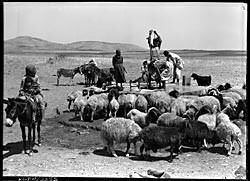
With the outbreak of World War II, Hurley was given the rank of acting Major to serve as a photographer and cinematographer, gaining an OBE for his work. Frank Hurley used photography to achieve the effect he desired and he was known for his ability to engage the public's imagination. In 1940, he returned to war photography with the Australian Imperial Forces (AIF) in the Middle East and remained over there until 1946.
In his diary entries during 1941 Hurley made frequent references to the Middle Eastern landscape and to the history of the so-called 'Holy Land'. He noted the changes in the cities since his first visit in 1917, his impressions of the progress and management of the war and his observations on the day to day lives of both Arabs and Jews. Thus Hurley's more familiar images of Australian troops in the Middle East, taken during 1941, are mingled with these evocative images of the local people continuing their everyday lives in the midst of war. Given the troubled nature of these regions today Hurley's photographs, taken during the greatest war in history, ironically document a seemingly less divided and tormented Middle East.
On 4 June 1941, he wrote:
This historic field of northern Palestine which has been the battlefield of bygone ages and there the Light Horse put the enemy to flight with the last war is likely to be once again the scene of conflict. At present it all seems so serenely peaceful that were it not for transports and artillery travelling trundling along the roads at mechanised speed one might think all the world at rest and content.
The contrasts of peace and war are very remarkable in this Land of Antiquity. It seems to be a land for reverential reminiscence – its very soil and ancient olive trees exhale the wondrous past and create an atmosphere that makes one ponder with some reverential awe. Here one sees inhabitants that seem to have existed from Bible days – They have not altered their customs nor methods – for why should they in this land so undisturbed by commercial competition. They grow their olives, till the soil as they did thousands of years ago. Shepherd their flocks as in the days of Abraham and seem as changeless as time. Amidst all this comes tanks, mechanised artillery and bombing planes.
Frank Hurley used photography to achieve the effect he desired and he was known for his ability to engage the public's imagination. In 1940, he returned to war photography with the AIF in the Middle East and remained over there until 1946.
In his diary entries during 1941 Hurley made frequent references to the Middle Eastern landscape and to the history of the so-called 'Holy Land'. He noted the changes in the cities since his first visit in 1917, his impressions of the progress and management of the war and his observations on the day to day lives of both Arabs and Jews. Thus Hurley's more familiar images of Australian troops in the Middle East, taken during 1941, are mingled with these evocative images of the local people continuing their everyday lives in the midst of war. Given the troubled nature of these regions today Hurley's photographs, taken during the greatest war in history, ironically document a seemingly less divided and tormented Middle East.
